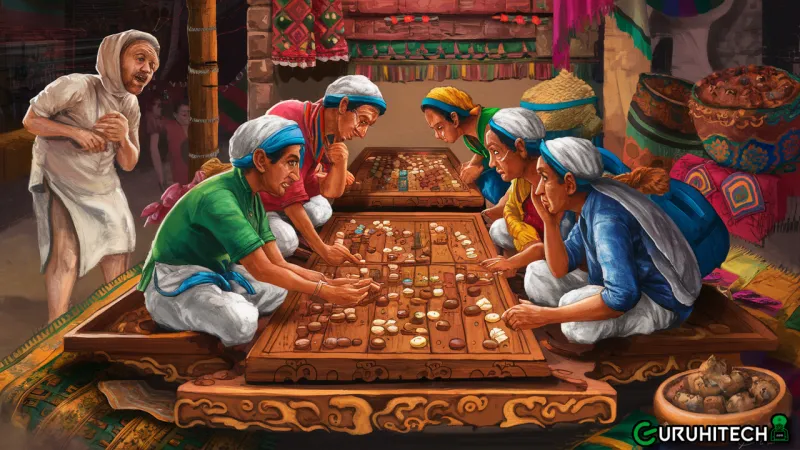Exploring the Traditional Game of Daman: A Journey Through Culture and Heritage

In a world increasingly dominated by digital entertainment, the charm of traditional games remains undiminished. One such game, steeped in history and cultural significance, is the Damangame in. Known by various names across different regions, Daman is a traditional board game that has been played for centuries, offering not just entertainment but also a glimpse into the cultural fabric of societies where it thrives.
What is the Daman Game?
Daman, also known as “Tiger and Goat,” “Bagh Chal” in Nepal, or “Alquerque” in some Arabic cultures, is a strategy board game with a rich heritage. The game involves two players, each taking on distinct roles: one player controls a set of “tigers,” while the other controls a group of “goats.” So the objective and rules may vary slightly depending on the region, but the core gameplay involves strategy, foresight, and tactical maneuvering.
The Board and Pieces
The Daman board typically consists of a grid with intersecting lines forming multiple triangles or squares. So the number of tigers and goats also varies, but a common version includes:
- Tigers: 2-4 pieces
- Goats: 20 pieces
This pieces are placed at the intersections of the lines, with tigers positioned at specific starting points while goats are placed progressively.
Rules of the Game
The primary goal for the player controlling the tigers is to “capture” the goats by jumping over them, akin to capturing pieces in checkers. The player controlling the goats aims to trap the tigers, rendering them immobile and thus unable to capture more goats.
- Placement Phase: Goats are placed one by one at any vacant intersection on the board.
- Movement Phase: Once all goats are placed, the game transitions to the movement phase.
- Tigers can move along the lines to an adjacent point or capture goats by jumping over them to an empty point beyond.
- Goats move to adjacent points to block tigers’ movements strategically.
Victory is achieved when all tigers are immobilized or when tigers capture a predetermined number of goats.
Historical Significance
The origins of the Daman game trace back to ancient times, with variations found in several cultures around the world. In Nepal, Bagh Chal is deeply rooted in local traditions, symbolizing the struggle between predators and prey. In the Middle East, Alquerque served as a precursor to the modern game of checkers. The game’s widespread presence across diverse cultures highlights its universal appeal and enduring relevance.
Cultural Impact
Playing Daman goes beyond mere entertainment; it is a cultural practice that fosters community interaction and preserves historical narratives. Elders often pass down the rules and strategies to younger generations, ensuring the game’s survival and continuity. Moreover, the game serves as an educational tool, enhancing cognitive skills such as strategic thinking, planning, and problem-solving.
Modern Resurgence
Despite the onslaught of digital gaming, traditional games like Daman are witnessing a resurgence. Efforts to revive and preserve these games are gaining momentum, with enthusiasts and cultural organizations promoting them through various means:
- Workshops and Tournaments: Local and international events celebrate these traditional games, drawing participants and spectators alike.
- Digital Adaptations: Modern technology is also being harnessed to create digital versions of Daman, making it accessible to a broader audience and ensuring its relevance in the digital age.
How to Get Started
Interested in exploring the world of Daman? Here’s how you can start:
- Find a Board: Traditional Daman boards can be purchased online or handcrafted. Alternatively, you can draw the grid on paper or a flat surface.
- Learn the Rules: Familiarize yourself with the rules, which may vary slightly based on the version you choose to play.
- Practice: Engage with friends or family members, practicing different strategies to hone your skills.
Conclusion
The Daman game is more than just a pastime; it is a testament to human ingenuity, cultural diversity, and the timeless allure of strategic play. By exploring and preserving such traditional games, we not only keep our heritage alive but also enrich our modern lives with the wisdom and joy of the past. So, whether you are a seasoned player or a curious novice, the world of Daman awaits – a world where every move tells a story and every game is a journey through time.
Ti potrebbe interessare:
Segui guruhitech su:
- Google News: bit.ly/gurugooglenews
- Telegram: t.me/guruhitech
- X (Twitter): x.com/guruhitech1
- Bluesky: bsky.app/profile/guruhitech.bsky.social
- GETTR: gettr.com/user/guruhitech
- Rumble: rumble.com/user/guruhitech
- VKontakte: vk.com/guruhitech
- MeWe: mewe.com/i/guruhitech
- Skype: live:.cid.d4cf3836b772da8a
- WhatsApp: bit.ly/whatsappguruhitech
Esprimi il tuo parere!
Ti è stato utile questo articolo? Lascia un commento nell’apposita sezione che trovi più in basso e se ti va, iscriviti alla newsletter.
Per qualsiasi domanda, informazione o assistenza nel mondo della tecnologia, puoi inviare una email all’indirizzo [email protected].
Scopri di più da GuruHiTech
Abbonati per ricevere gli ultimi articoli inviati alla tua e-mail.
